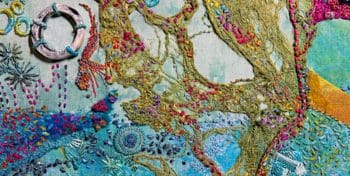How To Make a Face Mask – And the Research Behind it
I spent this past weekend researching and making face masks.
I wanted to read as much as I could on the efficacy of face masks, since we’ve been given a great deal of differing opinions. When the U.S. began talking about COVID19 it was generally advised that we not buy and wear face masks. It was said that these were needed and worn in hospitals and that everyday citizens were not going to benefit from wearing them.
As the virus spread throughout the States, the wording began to change. People were encouraged to wear a face mask if they suspected they were sick so as to mitigate spreading their germs to others whom they came into contact with. And then last week articles began appearing asking people who know how to sew to make and donate masks. There were articles rating the best materials to use to make a face mask and on the CDC’s website there was this:
HCP use of homemade masks:
In settings where facemasks are not available, HCP might use homemade masks (e.g., bandana, scarf) for care of patients with COVID-19 as a last resort. However, homemade masks are not considered PPE, since their capability to protect HCP is unknown. Caution should be exercised when considering this option. Homemade masks should ideally be used in combination with a face shield that covers the entire front (that extends to the chin or below) and sides of the face.
So I began looking around for hypoallergenic material and elastic, only to find these things were hard to find, if one could find them at all. After a bit more research, I found a number of patterns and began testing them out. A few were pretty simple and easy to make, but the one I liked best was on a site called, Instructibles.com by ashevillejm. The reason I liked her pattern the best was because it had a sleeve enabling you to insert a filter, which sounded smart, and also would then be thrown away after each use, and in keeping with the CDC’s recommendations. Her pattern used elastic, which made it easier to take on and off and covered the chin. I also found that with a little tweaking I could adapt my face mask to fully conform to the wearers face by adding the length of the wire and adding two wires instead of using just one.
I decided that the elastic, now in short supply, could be substituted with hair bands as per the CDC’s advise: “Facemasks with elastic ear hooks may be more suitable for re-use.” I also wanted mine to be durable enough to go through the hot water cycle of a washing machine and a hot dryer as the masks should be laundered after each use. UPDATE: The masks should be sterilized after each use. I have been throwing mine and my family’s in boiling water for 20 minutes. The elastic is more likely to wear out, on the other hand, fabric ties are harder to put on and take off. I opted for hair ties.
I then set about perfecting my facemark, opting for batik fabric as it’s a bit denser than most cotton fabrics. I tried using a third layer of interfacing, but it did make breathing a little more difficult, and I found it claustrophobic, but others may find interfacing doesn’t hinder their breathing, in which case, if it were me, I’d include it. (I would be concerned about breathing in the chemicals present in fusible interfacings though.) According to the CDC a tissue can be used to cover one’s mouth, so it seems that inserting a layer of kleenex or something like that into the insert might be helpful.
After sewing up a number of masks, I went ahead and shot and edited a tutorial so those of us who are visual learners, could easily make the mask too. Finally I uploaded the video to my YouTube Channel: Ariane Zurcher ~ On the Other Hand and added a disclaimer with lots of links in the description including the materials needed and alternatives if those materials couldn’t be found.
I understand that people are frightened and it’s difficult to know whom to believe these days as there are a great many differing views, however I do think it’s important to try and follow the CDC’s recommendations whenever possible and do the best we can.
Let’s stay safe everyone, and try to be kind to one another. These are difficult times and we are all doing the best we can to help in whatever ways we can.





Recent comments